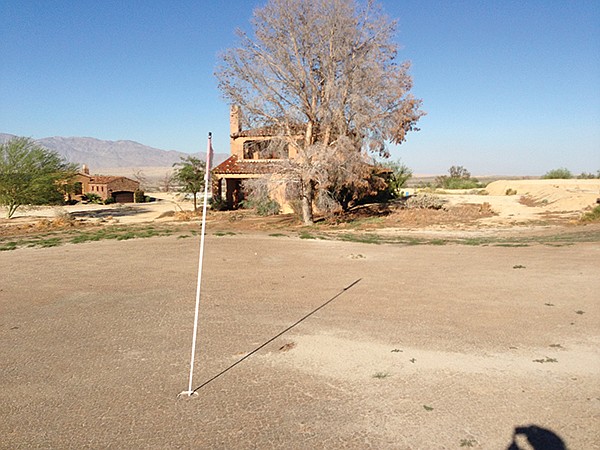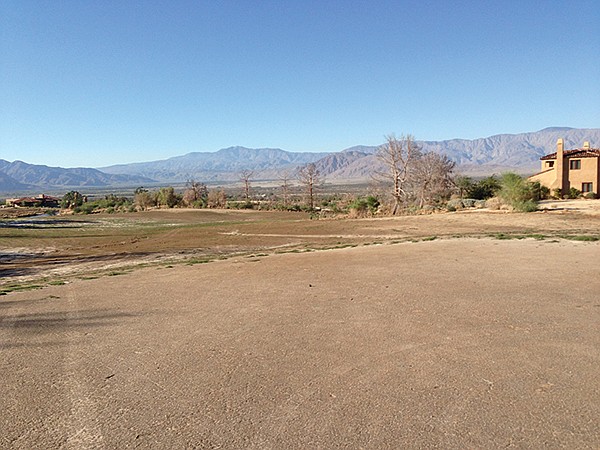 Facebook
Facebook
 X
X
 Instagram
Instagram
 TikTok
TikTok
 Youtube
Youtube

Tiny, water-deficient Borrego Springs (population 3500) may be a microcosm of what San Diego will be if the water crisis worsens. Borrego is betting the farm — actually, betting on leveling farms — for its survival. San Diego County may not have enough farms to adopt Borrego’s strategy, but it certainly could learn something from the little town in the northeast part of the county.
The only question is whether Borrego’s plan will work. For more than half a century, Borregans have said their town would be “the next Palm Springs.” But since the 1980s, financially troubled developers and asset flippers have pumped more than $100 million into the town while taking big losses.
Now, Borrego is making real estate developers buy and fallow farmland if they want to build homes. Fruit farms, nurseries, and the like use 70 percent of Borrego’s water. Once they have drilled a well, their basic water cost is electricity to pump the stuff out. “These are industrial conglomerates, not mom-and-pop farms,” says Borregan Ray Shindler. “They came to Borrego in the 1950s and 1960s because they saw cheap water.”
So, a developer building a home has to obtain a farm, cut down the trees, restore the desert landscape, and shovel out other funds to make the place presentable. With leveled farms using no more water, there is some available for homes being constructed. So, what do you suppose is happening to farm prices? Zoom! “Farmers aren’t dumb. They are smart,” says Shindler, pointing to a potato farm that is on the market for three times what it is worth.
On the other hand, says longtime resident Lane Sharman, San Diego Gas & Electric costs are so high “that farming is becoming less and less economical.”
Farmers might sell their land at reasonable prices. If there is demand for new development — and that is a very big “if” — Borrego’s strategy might work, although Sharman thinks the water-use ratio of fallowed farms to new homes should be 3 to 1 or even 5 to 1, instead of roughly 1 to 1 or 2 to 1.
“Pardon the pun, but the water-mitigation policy here has been watered down; at one time the ratio was 3 to 1.”
According to the United States Geological Survey, the Borrego Valley pumps 19,000 acre-feet of water per year. Only 5600 acre-feet is replaced through, mostly, rainfall. That creates “an overdraft of 13,000 to 14,000 feet per year,” says Jerry Rolwing, general manager of the Borrego Water District. At this drawdown rate, big trouble hits Borrego in 50 years, he says. Some say 45 years is more like it. “Other options may be possible but, at present, are too expensive for the residents of Borrego Springs.”
In one sense, Borrego’s plan is old hat: throughout the world, over many decades, farms have been sold for real estate development. In another sense, the approach seems counterintuitive: a town running out of water is counting on economic growth — residential development and tourism — to keep the taps flowing.
Borrego is not near a freeway and is so hot in the summer that many (if not most) residents do not stick around. July temperatures range from nighttime lows of 75 degrees Fahrenheit to daytime highs of 107. People have to go elsewhere to do much of their shopping. The town hardly has “luxury” written all over it.

But optimists are counting on two facilities to power the expected growth. One is Rams Hill, a residential development that has been through bankruptcy twice, with myriad financial problems. The other is La Casa del Zorro, a resort that was closed and is now being resuscitated. Its guests have always played on the Rams Hill golf course, which reopens next month.
In recent years, the championship course has been closed and gone to seed, as winds blew over dead and dying trees. Rams Hill housing values plunged from a 2006 high of $270 a square foot to $63. Prices are coming back, but there is controversy on how much.


In July of last year, Denver developer Terry Considine, who once owned the El Cortez briefly and is a member of a prominent San Diego family, joined with Bill Berkley to buy Rams Hill’s 3000 acres, the golf course, and the clubhouse for $842,000. They paid off long-defaulted bonds and homeowner fees, settled a dispute with the Borrego Water District, drilled wells that Berkley says are not tied in with the main aquifer, set up a solar energy system, and brought the golf course back to life. “We spent $10 million, and we’re not done yet,” says Berkley.
A full 93 percent of Rams Hill residents, suffering from the steep decline in home values, voted to pay a $1200-a-year special assessment to help run the golf course and the clubhouse. “I would say 70 percent of present homeowners do not play golf,” says Berkley — proof of how much home values mean to residents. However, even before the course was closed, few were playing.
Berkley says he has seen some home resale values come back to $170 to $180 a square foot, but, says Joe Tatusko, who joins the Borrego Water District board December 5, “Checking the online home price services, I am not convinced prices are up. It is too early to say.”
La Casa del Zorro, the former money-losing Copley family property, was purchased last year by a group including former San Diego city manager Jack McGrory. The resort “still has growing pains” but is going forward and even experienced a profit — a rarity for the facility — in March of this year, says Linda Haddock, executive director of the Borrego Springs Chamber of Commerce.
“Tourism is key for the long-term success of the Borrego Springs community,” says Tatusko.
The newly formed Borrego Water Coalition is searching for ways to build a groundwater-sustainability plan, as required by state legislation passed in August.
Berkley is an optimist: “There are probably in excess of a thousand lots that can be built on and sold. So if we can restore the value of those lots by driving demand with a high-quality golf course and clubhouse,” the investment will pay off, despite previous failed attempts.
But Borregans “don’t have the will power” to put enough teeth in plans to fallow farms, says Shindler. “We’re pretty insular.”
Says groundwater geologist John Peterson, who warned in the 1980s of Borrego’s problems, “We know Borrego will never be a Palm Springs. We have water and access problems. Palm Springs has the I-10. Borrego will never have a freeway, and we don’t want it.”


Tiny, water-deficient Borrego Springs (population 3500) may be a microcosm of what San Diego will be if the water crisis worsens. Borrego is betting the farm — actually, betting on leveling farms — for its survival. San Diego County may not have enough farms to adopt Borrego’s strategy, but it certainly could learn something from the little town in the northeast part of the county.
The only question is whether Borrego’s plan will work. For more than half a century, Borregans have said their town would be “the next Palm Springs.” But since the 1980s, financially troubled developers and asset flippers have pumped more than $100 million into the town while taking big losses.
Now, Borrego is making real estate developers buy and fallow farmland if they want to build homes. Fruit farms, nurseries, and the like use 70 percent of Borrego’s water. Once they have drilled a well, their basic water cost is electricity to pump the stuff out. “These are industrial conglomerates, not mom-and-pop farms,” says Borregan Ray Shindler. “They came to Borrego in the 1950s and 1960s because they saw cheap water.”
So, a developer building a home has to obtain a farm, cut down the trees, restore the desert landscape, and shovel out other funds to make the place presentable. With leveled farms using no more water, there is some available for homes being constructed. So, what do you suppose is happening to farm prices? Zoom! “Farmers aren’t dumb. They are smart,” says Shindler, pointing to a potato farm that is on the market for three times what it is worth.
On the other hand, says longtime resident Lane Sharman, San Diego Gas & Electric costs are so high “that farming is becoming less and less economical.”
Farmers might sell their land at reasonable prices. If there is demand for new development — and that is a very big “if” — Borrego’s strategy might work, although Sharman thinks the water-use ratio of fallowed farms to new homes should be 3 to 1 or even 5 to 1, instead of roughly 1 to 1 or 2 to 1.
“Pardon the pun, but the water-mitigation policy here has been watered down; at one time the ratio was 3 to 1.”
According to the United States Geological Survey, the Borrego Valley pumps 19,000 acre-feet of water per year. Only 5600 acre-feet is replaced through, mostly, rainfall. That creates “an overdraft of 13,000 to 14,000 feet per year,” says Jerry Rolwing, general manager of the Borrego Water District. At this drawdown rate, big trouble hits Borrego in 50 years, he says. Some say 45 years is more like it. “Other options may be possible but, at present, are too expensive for the residents of Borrego Springs.”
In one sense, Borrego’s plan is old hat: throughout the world, over many decades, farms have been sold for real estate development. In another sense, the approach seems counterintuitive: a town running out of water is counting on economic growth — residential development and tourism — to keep the taps flowing.
Borrego is not near a freeway and is so hot in the summer that many (if not most) residents do not stick around. July temperatures range from nighttime lows of 75 degrees Fahrenheit to daytime highs of 107. People have to go elsewhere to do much of their shopping. The town hardly has “luxury” written all over it.

But optimists are counting on two facilities to power the expected growth. One is Rams Hill, a residential development that has been through bankruptcy twice, with myriad financial problems. The other is La Casa del Zorro, a resort that was closed and is now being resuscitated. Its guests have always played on the Rams Hill golf course, which reopens next month.
In recent years, the championship course has been closed and gone to seed, as winds blew over dead and dying trees. Rams Hill housing values plunged from a 2006 high of $270 a square foot to $63. Prices are coming back, but there is controversy on how much.


In July of last year, Denver developer Terry Considine, who once owned the El Cortez briefly and is a member of a prominent San Diego family, joined with Bill Berkley to buy Rams Hill’s 3000 acres, the golf course, and the clubhouse for $842,000. They paid off long-defaulted bonds and homeowner fees, settled a dispute with the Borrego Water District, drilled wells that Berkley says are not tied in with the main aquifer, set up a solar energy system, and brought the golf course back to life. “We spent $10 million, and we’re not done yet,” says Berkley.
A full 93 percent of Rams Hill residents, suffering from the steep decline in home values, voted to pay a $1200-a-year special assessment to help run the golf course and the clubhouse. “I would say 70 percent of present homeowners do not play golf,” says Berkley — proof of how much home values mean to residents. However, even before the course was closed, few were playing.
Berkley says he has seen some home resale values come back to $170 to $180 a square foot, but, says Joe Tatusko, who joins the Borrego Water District board December 5, “Checking the online home price services, I am not convinced prices are up. It is too early to say.”
La Casa del Zorro, the former money-losing Copley family property, was purchased last year by a group including former San Diego city manager Jack McGrory. The resort “still has growing pains” but is going forward and even experienced a profit — a rarity for the facility — in March of this year, says Linda Haddock, executive director of the Borrego Springs Chamber of Commerce.
“Tourism is key for the long-term success of the Borrego Springs community,” says Tatusko.
The newly formed Borrego Water Coalition is searching for ways to build a groundwater-sustainability plan, as required by state legislation passed in August.
Berkley is an optimist: “There are probably in excess of a thousand lots that can be built on and sold. So if we can restore the value of those lots by driving demand with a high-quality golf course and clubhouse,” the investment will pay off, despite previous failed attempts.
But Borregans “don’t have the will power” to put enough teeth in plans to fallow farms, says Shindler. “We’re pretty insular.”
Says groundwater geologist John Peterson, who warned in the 1980s of Borrego’s problems, “We know Borrego will never be a Palm Springs. We have water and access problems. Palm Springs has the I-10. Borrego will never have a freeway, and we don’t want it.”
Comments